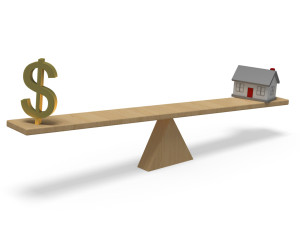One of the first questions that every real estate investor must address is whether to purchase a property with cash or finance it. If an investor lacks the funds to pay all cash, the answer is straightforward. Otherwise, the investor needs to consider the loan terms in light of his or her tolerance for risk.
Loans and Leverage
By financing most of the purchase price, the idea is to “use other people’s money” to make more on your initial investment. Under the right circumstances, an investor can receive a substantially higher return by putting a small amount down and financing the balance of the purchase price. This is often referred to as “leverage,” though “positive financial leverage” is the more accurate term.

Cash? or Leverage The Purchase?
Most people believe that they are properly leveraging an investment so long as the cost of the loan (the interest rate) is less than the return from the property. For example, if a loan has a 6% interest rate and the property is yielding a 7.5% return, wouldn’t that increase the overall return? It turns out that the answer is “maybe.”
When an investor makes loan payments, he or she is paying both principal and interest. The principal portion of th e loan payment reduces the cash return on the property just as does the interest portion. For a typical 30-year loan with a 6% interest rate, the total annual rate paid to service the loan works out to be 7.2%. The cost to service the loan is called the loan constant, and positive leverage exists only when the property return is higher than loan constant. In our example, we have a small amount of positive leverage since the property is returning 7.5%, slightly more than the 7.2% loan constant.
When the loan constant exceeds the property return, using a loan will decrease your returns. This is known as negative financial leverage. In our example, let’s assume that our investor is considering a 15-year loan (fully amortizing) since she can get a slightly lower interest rate of 5.75%. Since her primary goal is to leverage her investment, would this make sense?
The annual debt service (loan constant) on a 15-year, 5.75% loan works out to be almost 10% (9.96%). This is well above the property return rate of 7.5% and means that the investor’s total return will be lowered by taking out this loan. Given that this investor’s goal was to (positively) leverage her investment, she should pay cash or consider the 30-year loan despite its higher interest rate.
Risk Tolerance and Investment Objectives
All investors wish to maximize their returns. The difference is in the extent of risk they will tolerate to achieve higher returns. A retired individual living off his retirement nest egg will have a higher percentage of his portfolio in lower risk, capital-preserving investments like cash or bonds. Most 22 year olds will have portfolios heavily weighted with stocks or other higher risk, higher reward assets.
Using a loan to buy any asset is inherently more risky than paying cash for several reasons. A loan requires a loan payment—and the available funds to continue to make the payments until the loan is paid off. A loan that is not fully amortizing introduces interest rate risk. If your 5/1 Adjustable Rate Mortgage changes from 3% to 6%, your new payment may no longer be affordable.
That said, the loan risk is directly related to the specific piece of real estate or asset being financed. A loan to purchase a fully leased residential property in good condition will be less risky than one to buy an empty, poorly maintained one that will require extensive work and for which the property owner may, or may not have difficulty finding renters at the expected rental rate.
An investor should consider his or her financial objectives. Paying cash could make the most sense if real estate is being purchased as part of a strategy to replace low yielding money market accounts or bonds. Another investor with a portfolio heavily weighted with stocks might desire asset diversification with real property, but still wish to achieve the highest possible returns. This investing objective suggests leveraging the purchase—taking out a loan for the highest possible amount—could be the best decision.
Don’t forget: just because a given loan allows you to take a loan on 80% of the property value does not mean that you cannot choose a middle course to lighten the risk. Your investment needs might be better served by putting 40% down.
Checklist – Taking a Loan Vs. Paying Cash
In summary, consider the following five questions before deciding if you should pay cash or finance your purchase of real estate property:
- If you have decided to take out a loan simply because you do not have sufficient cash, should you consider a less expensive property?
- Am I purchasing real estate to substitute for low yielding safe investments such as money market funds or bonds, or am I doing so to achieve high returns in an asset class other than stocks (or other higher risk, higher rewards assets)?
- If my goal is to use a loan to leverage my invested capital, have I done enough due diligence and/or received professional advice to determine that taking out a loan would positively leverage, versus negatively leverage, my investment?
- How risky is the property I’m interested in purchasing relative to other real estate investments?
- Should I consider making a larger down payment—30% or more—so that I get some of the benefits of leverage without taking out the maximum loan to value that I might?
This is by no means an exhaustive list of issues to consider regarding purchasing real estate with all cash or by financing, but honest answers to these can provide a solid foundation for deciding of which option might be better for you.

